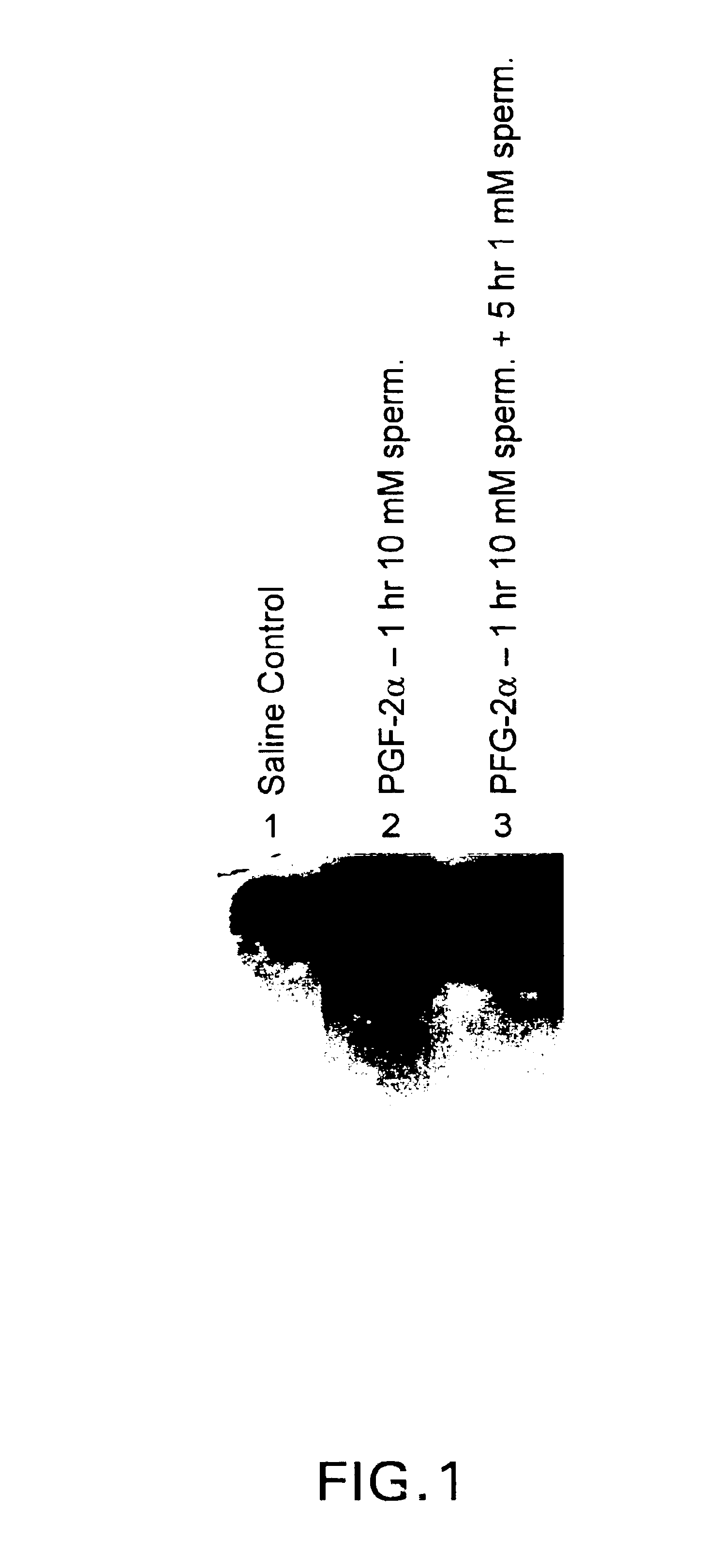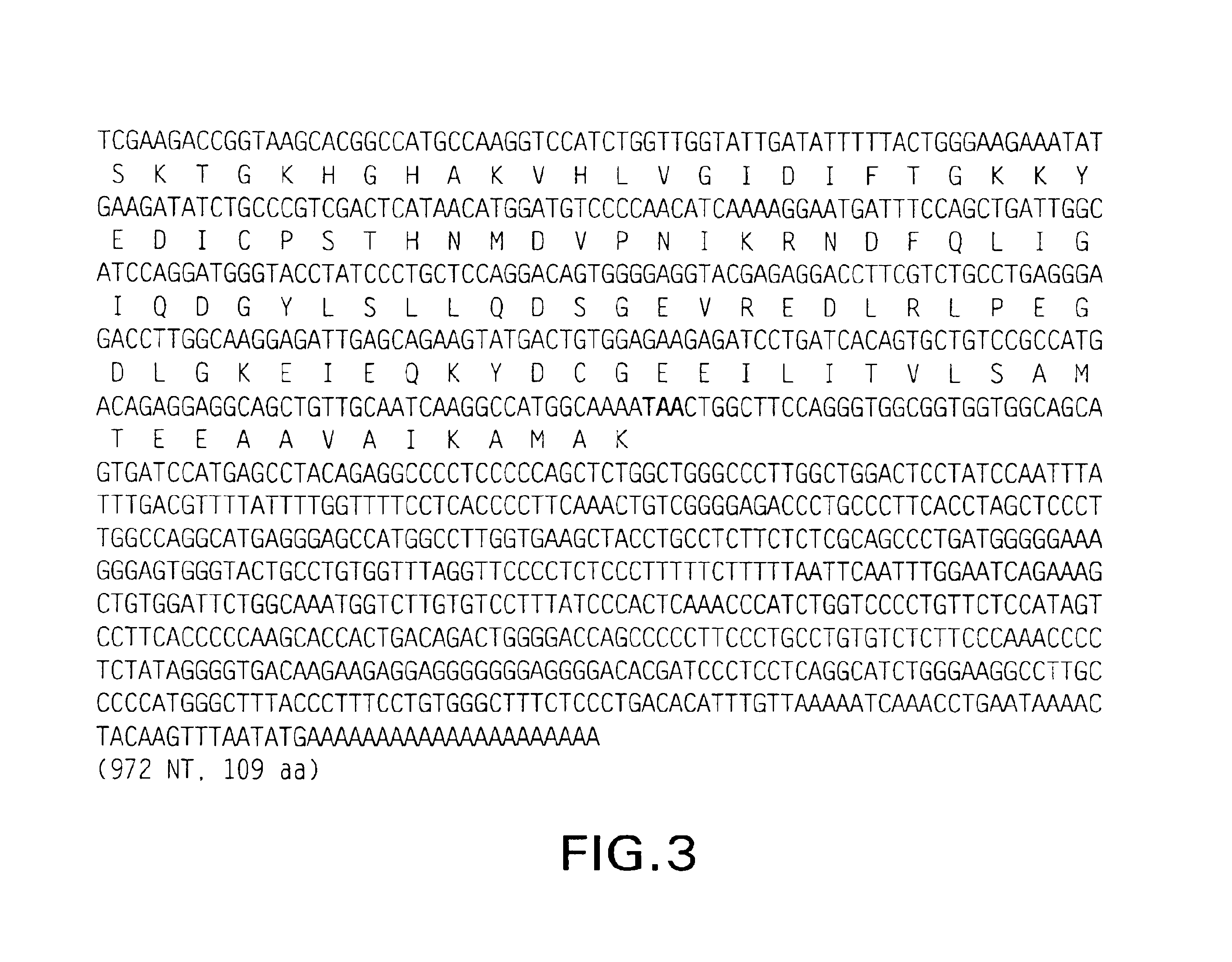DNA encoding apoptosis-induced eucaryotic initiation factor-5A and deoxyhypusine synthase and a method for controlling apoptosis in animals and humans
a technology of apoptosis and eucaryotic initiation factor, which is applied in the field of dna encoding apoptosis-induced eucaryotic initiation factor5a and deoxyhypusine synthase, can solve the problems of small decrease in total protein synthesis, the amount of apoptosis-induced dhs protein produced is reduced, and the method of controlling apoptosis and treating diseases by controlling apoptosis-induced
- Summary
- Abstract
- Description
- Claims
- Application Information
AI Technical Summary
Benefits of technology
Problems solved by technology
Method used
Image
Examples
example 2
RNA Isolation
Total RNA was isolated from corpus luteum tissue removed from rats at various times after PGF.sub.2.alpha. induction of apoptosis. Briefly, the tissue (5 g) was ground in liquid nitrogen. The ground powder was mixed with 30 ml guanidinium buffer (4 M guanidinium isothiocyanate, 2.5 mM NaOAc pH 8.5, 0.8% .beta.-mercaptoethanol). The mixture was filtered through four layers of Miracloth and centrifuged at 10,000.times.g at 4.degree. C. for 30 minutes. The supernatant was then subjected to cesium chloride density gradient centrifugation at 11,200 g for 20 hours. The pelleted RNA was rinsed with 75% ethanol, resuspended in 600 .mu.l DEPC-treated water and the RNA precipitated at -70.degree. C. with 1.5 ml 95% ethanol and 60 .mu.l of 3M NaOAc. Twenty .mu.g of RNA were fractionated on a 1.2% denaturing formaldehyde agarose gel and transferred to a nylon membrane. Randomly primed 32P-dCTP-labeled full length eIF-5A cDNA (SEQ ID NO:1) or partial length DHS cDNA (SEQ ID NO. 6) w...
example 3
Generation of an Apoptosing Rat Corpus Luteum RT-PCR Product Using Primers Based on Yeast, Fungal and Human eIF-5A sequences
A partial-length apoptosis-induced eIF-5A sequence (SEQ ID NO. 111) corresponding to the 3' end of the gene was generated from apoptosing rat corpus luteum RNA template by RT-PCR using a pair of oligonucleotide primers designed from yeast, fungal and human eIF-5A sequences. The upstream primer used to isolate the 3'end of the rat eIF-5A gene is a 20 nucleotide degenerate primer: 5'TCSAARACHGGNAAGCAYGG 3' (SEQ ID NO. 9), wherein S is selected from C and G; R is selected from A and G; H is selected from A, T, and C; Y is selected from C and T; and N is any nucleic acid.
The downstream primer used to isolate the 3'end of the rat eIF-5A gene contains 42 nucleotides: GCGAAGCTTCCATGGCTCGAGTTTTTTTTTTTTTTTTT 3' (SEQ ID NO. 10). A reverse transcriptase-polymerase chain reaction (RT-PCR) was carried out as follows: Using 5 .mu.g of the downstream primer, a first strand of...
example 4
Isolation of Genomic DNA and Southern Analysis
Genomic DNA for southern blotting was isolated from excised rat ovaries. Approximately 100 mg of ovary tissue was divided into small pieces and placed into a 15 ml tube. The tissue was washed twice with 1 ml of PBS by gently shaking the tissue suspension and then removing the PBS using a pipette. The tissue was resuspended in 2.06 ml of DNA-buffer (0.2 M Tris-HCl pH 8.0 and 0.1 mM EDTA) and 240 .mu.l of 10% SDS and 100 .mu.l of proteinase K (Boehringer Manheim; 10 mg / ml) was added. The tissue was placed in a shaking water bath at 45.degree. C. overnight. The following day another 100 .mu.l of proteinase K (10 mg / ml) was added and the tissue suspension was incubated in a waterbath at 45.degree. C. for an additional 4 hours. After the incubation the tissue suspension was extracted once with an equal volume of phenol:chloroform:iso-amyl alcohol (25:24:1) and once with an equal volume of chloroform:iso-amyl alcohol (24:1). Following the extr...
PUM
| Property | Measurement | Unit |
|---|---|---|
| body weight | aaaaa | aaaaa |
| Tm | aaaaa | aaaaa |
| temperature | aaaaa | aaaaa |
Abstract
Description
Claims
Application Information
 Login to View More
Login to View More - R&D
- Intellectual Property
- Life Sciences
- Materials
- Tech Scout
- Unparalleled Data Quality
- Higher Quality Content
- 60% Fewer Hallucinations
Browse by: Latest US Patents, China's latest patents, Technical Efficacy Thesaurus, Application Domain, Technology Topic, Popular Technical Reports.
© 2025 PatSnap. All rights reserved.Legal|Privacy policy|Modern Slavery Act Transparency Statement|Sitemap|About US| Contact US: help@patsnap.com



